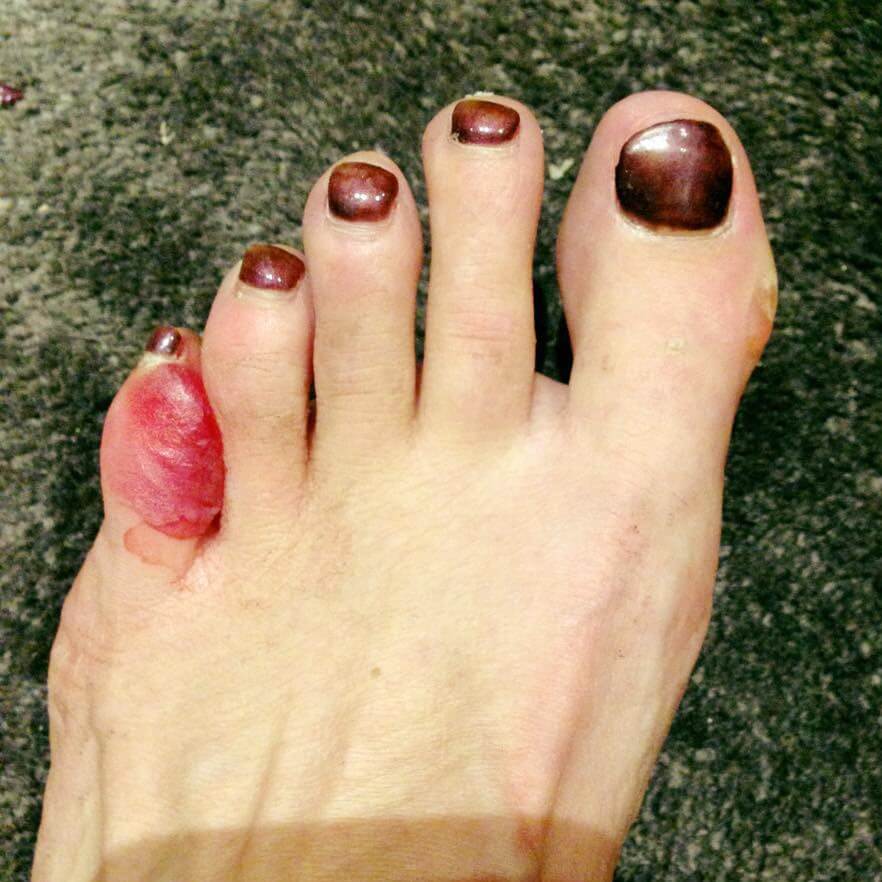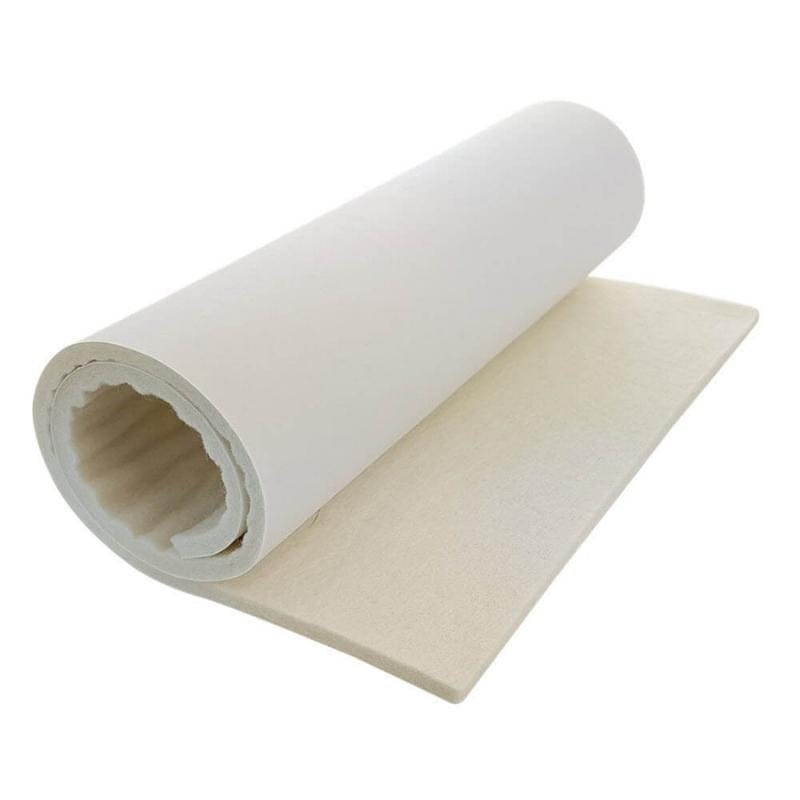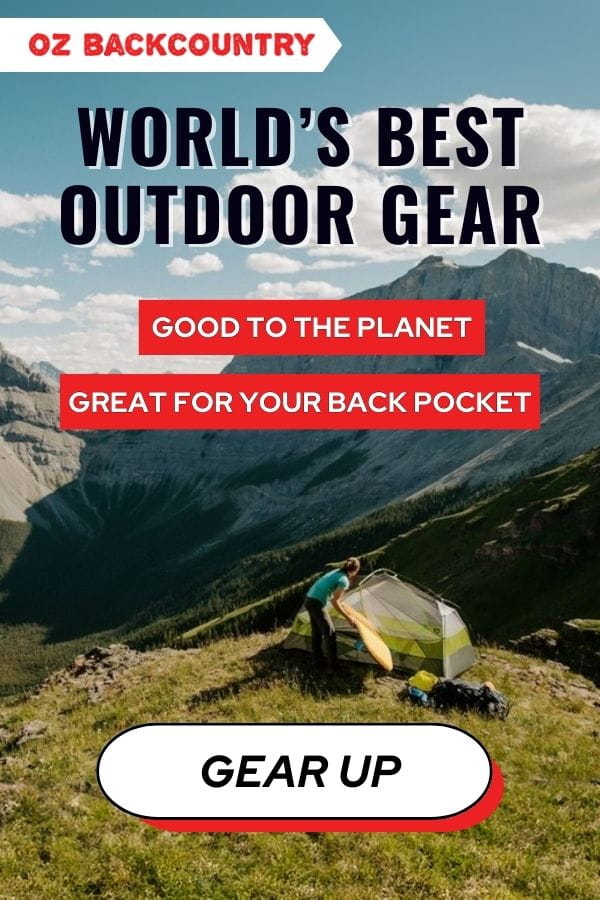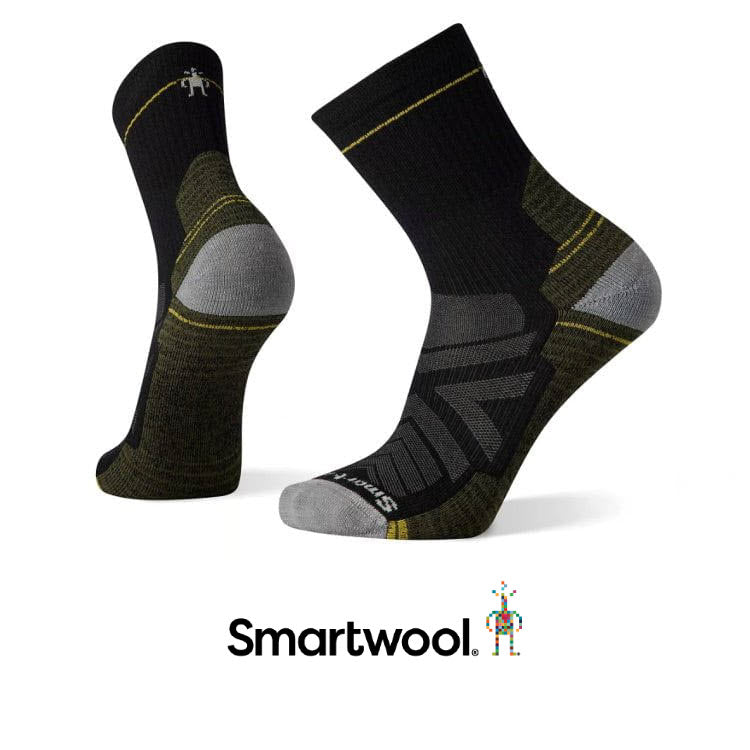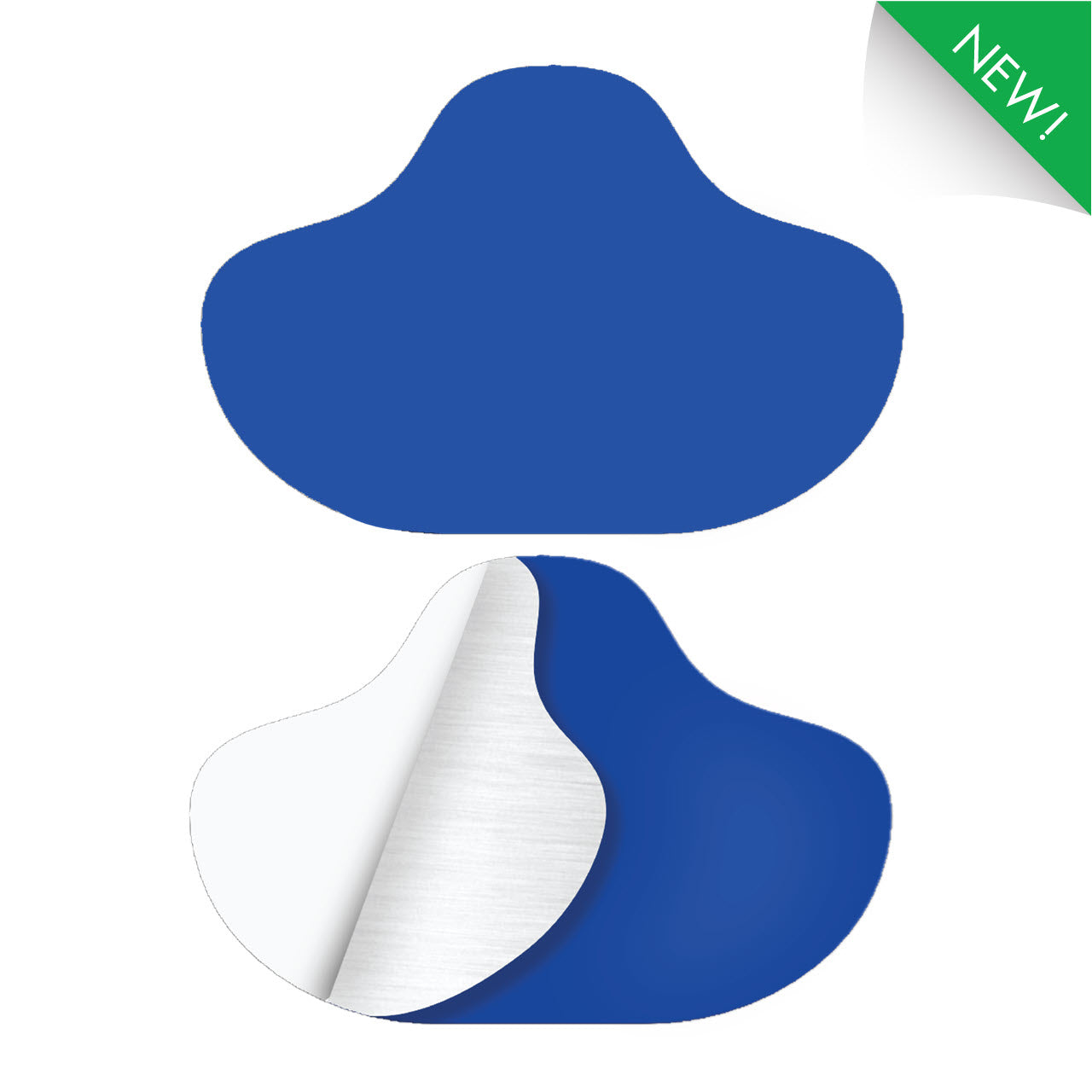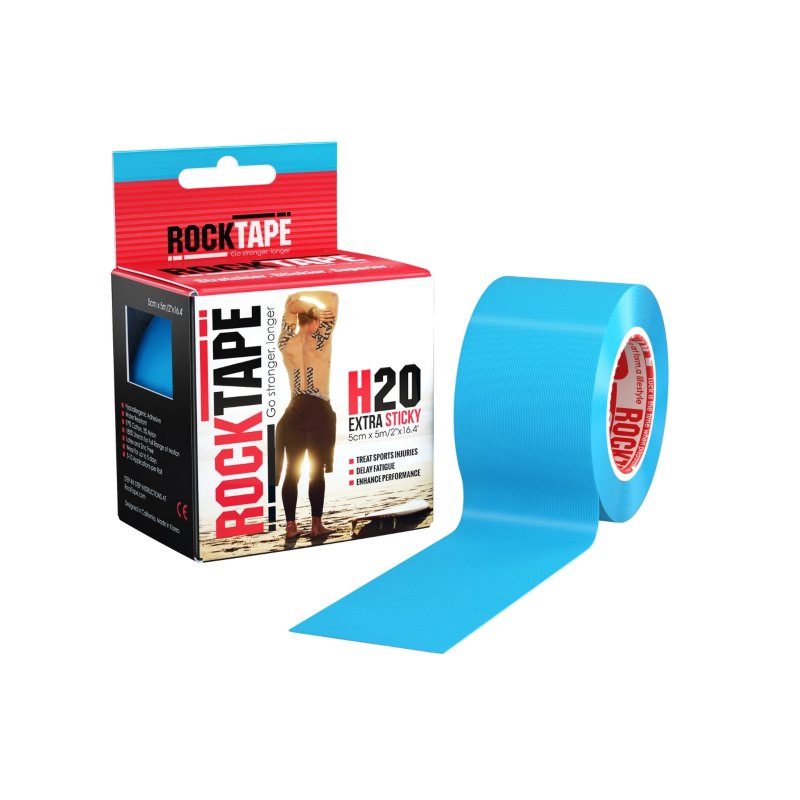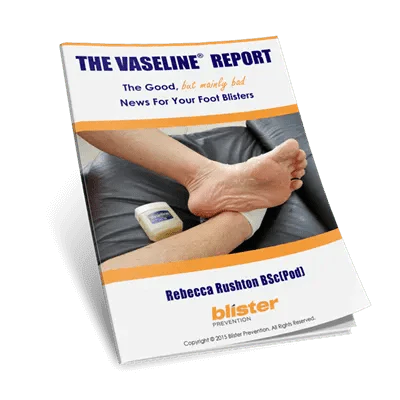Blisters between toes are common to both endurance running and walking activities. They are really difficult to get relief from, so prevention is the key!
There Are Two Types of Blisters Between Toes
- True interdigital blisters – Literally blisters between two toes. These aren't as common as the next type.
- Pinch blisters – Blisters towards the bottom or end of the toe, common with adductovarus (curly) toes. The underside of the toe often takes on a triangular shape. These blisters are a result of how one toe curls under the next one. The toe basically gets 'trodden on' with every step.
LEARN MORE ABOUT PINCH BLISTERS HERE
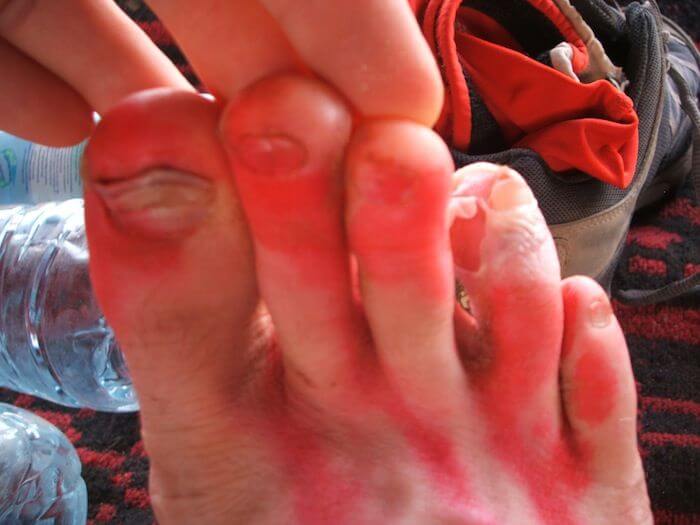
A true interdigital blister on the curly 4th toe in an athlete (image courtesy Christian Madsen)
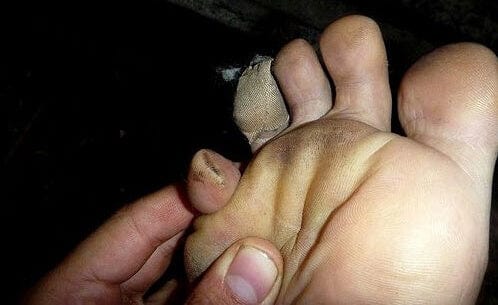
Pinch callous turned pinch blister
Toe Anatomy
Toes are bony little things. There are 3 phalanges (toe bones) in each toe (except the big toe which has 2, like your thumb). Phalanges aren't smooth straight bones, they're pretty lumpy. Look at the x-ray of the big toe and second toe. In this image you can see the soft tissue of each toe and even the nails if you look closely. And you can see the phalanges under the skin. Notice how they are wide at the ends and skinny in the middle.
Even at the best of times, you can see how the bony prominence of one toe can press on the bony prominence of the adjacent toe. This is even more-so when a toe is bent or curly - one gets "trodden on" and pinched. And the toes don't necessarily remain still in the shoe as you walk and run. They move relative to one another.
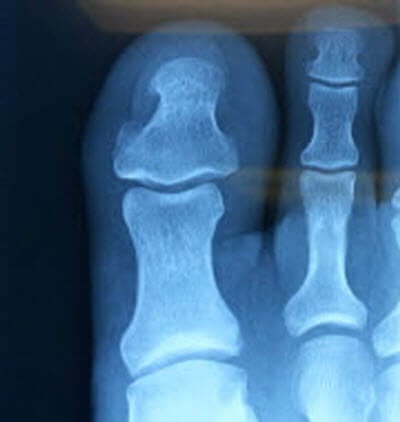
Notice how the phalanges are skinny in the middle and wide at the ends.
How To Stop Getting Blisters Between Toes
1. Foam or Gel Wedges
Foam and gel (pictured) wedges keep the toes physically separated and cushion bony prominences. The gel material absorbs a lot (repeat, a lot) of shear via its very low shear modulus. Interdigital wedges are almost always comfortable because the material is soft. But they can dislodge and move around, because apart from the toes sitting close together, there's nothing actually holding them in place. In-shoe conditions (sweat/grit) cause them to degrade prematurely, especially foam wedges. These products are available at pharmacies and from some podiatrists. Please note, you probably won't be able to fit a wedge between all your toes - it will spread them too much and will feel tight in your shoe.
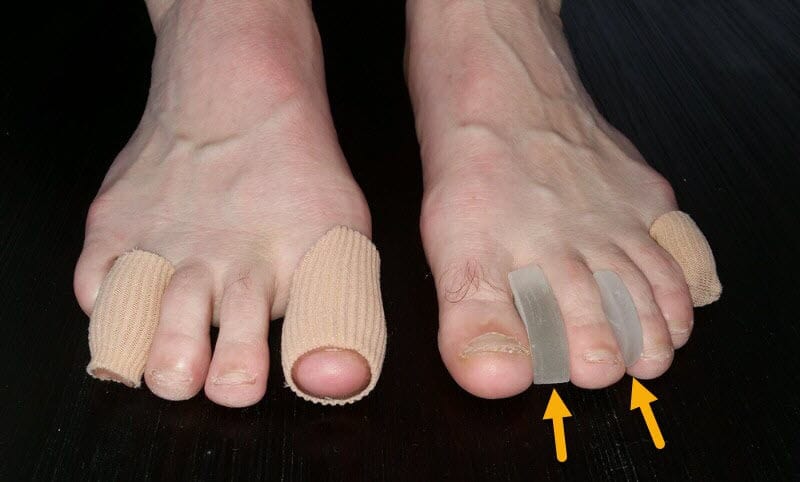
Gel toe wedges (right - yellow arrows) reduce interdigital pressure and absorb blister-causing forces
2. Gel Toe Protector Caps & Sleeves
These are like a little sock for an individual toe and come either open or closed at one end. The best ones have gel all around, thereby providing 360 degree toe protection to prevent blisters between toes. Compared to the wedges (above), they are more likely to stay in place because they are elasticised. The gel material is the same so they still absorb a lot of blister-causing shear. They encapsulate the soft tissue component of the toe so it’s not getting "trodden on" as much with each step.
Some people find they make the skin too sweaty; and I have seen this happen (a runner whose skin became macerated after 6 hours of wear). But I have also seen an ultramarathoner wear one of these 24/7 for 6 days (6-day ultramarathon) without skin maceration. Like everything, tolerance is very individual, but I highly recommend trying them. We have the BlisterPod brand of gel toe protectors. They have a deluxe double-thick gel layer compared to all other brands and they have been designed with stubborn pinch blisters in mind. These blisters need more protection than most others.
3. Custom-Made Wedges or Toeprops (made by your podiatrist)
Otoform K is a moldable putty material that sets and holds its shape. Podiatrists use it frequently to achieve an even pressure along the entire interdigital space, in spite of even the most significant toe deformities. The aim is either to get the toe to sit straighter; or if not, at least prevent high focal pressure by moulding the material to the interdigital space. We prevent blisters between toes, callouses and corns with these custom-made devices.
You need to be standing while the material sets - because non-weightbearing toe alignment is different to weightbearing alignment. The good thing about Otoform K is it's long-lasting (at least 6 months) and is easy to keep clean. However, they aren’t always tolerated because they can feel hard and foreign. The video below shows me making a prop (a bit more involved than a simple wedge) for my toes - just so you can get the idea.
4. Pre-Taping
Taping is a good place to start for preventing blisters between toes, but don't be surprised if it doesn't do enough - it has its limitations. Tapes or dressings can be used to reposition a toe, to encapsulate the soft tissue of the toe or spread shear load. To reposition a toe eg: a curly toe that tucks in & under the next toe, you can tape it up & out so that it sits a bit straighter. Here's a video demonstration. But tape stretches and/or comes loose over time so it requires reapplication each day or sometimes several times a day depending on your activity. Also, sweat is a constant threat to adhesion.
For toes that suffer pinch blisters, often the fleshy underside of the toe is misshapen to the point where it can be triangular! Anything that can hold this soft tissue in and less triangular, means there’s less toe that the next toe can tread on – and that means less blisters. Below is a video on my toe taping technique that I learned from Anna Beetham. There are all sorts of different tapes used in blister prevention. None of them are really made for blisters, they’re made for other purposes: Fixomull Stretch is the one I generally use - it’s the one in the video. We sell it from our online store if you can’t get it elsewhere.
5. Lubricants
Lubricants reduce friction. Reapply often, as research shows that after around 90 mins, even the greasiest ones increase friction levels above baseline measures. There are a few other downsides to lubricants. Take a look at this video where I run through a bunch of topical blister products, including lubricants.
6. Toesocks (The ONLY Sock That Addresses Blisters Between Toes)
Toe-socks add a little more bulk to the interdigital space so they work a bit like an interdigital wedge by cushioning. They also work like a double-sock system by forming an additional interface (sock-sock) at the interdigital space. But double-socks rely on different materials being used for friction-reducing properties and this is not the case with toesocks – it’s the same material on each side. But this small difference may be enough to stop blisters. The most common brand of toe-socks is Injinji. While toesocks can reduce interdigital blisters, it's not difficult to understand how they can cause the shoe to get too tight in the toebox and cause additional pressure and more blisters to the outside of the big and little toe.
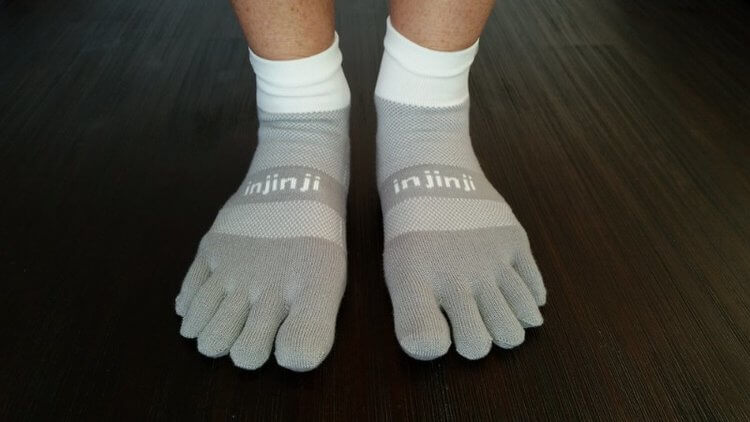
Toesocks cushion the interdigital space to help prevent blisters
7. ENGO Patches on Toesocks
If an interdigital blister has already formed, you’ll have a hard time getting much relief. I don’t like using gel toe protectors once a blister is already there as maceration will compound the blister itself. In race situations, the best relief I’ve managed to get for blisters between toes with runners who wear toesocks (which didn’t prevent the blister) where we apply strips of an ENGO Patch to the socks, much like the picture below. I've written about the technique thoroughly here. Wrap it around the sock so that the ends meet on the top. Don't apply any compression around the toe, just in case your feet swell further! Just lay it on and press to adhere. This is a great way to reduce friction levels if you’re in a pinch. You can learn more about how ENGO patches work here. The only problem is it won't last like ENGO usually does where you put it on the shoe or insole.
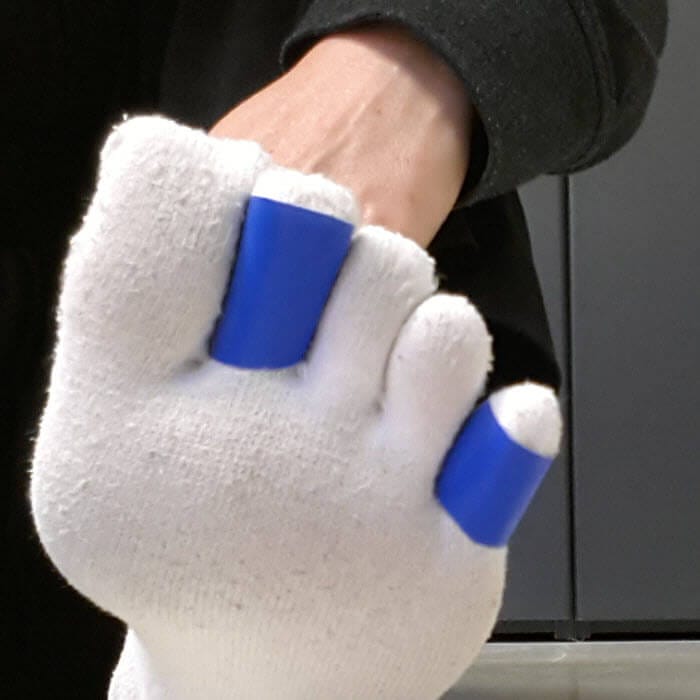
The best relief I’ve managed to get was with a runner who was wearing toesocks (which didn’t prevent the blister) and we applied strips of an ENGO Rectangle patch to the toesocks. It was an expensive way around the problem, but the relief it gave was race-saving.
I've used the ENGO Rectangle Pack in the photo above, and have also used the large ovals from the ENGO 4-Pack. Check out the entire range at our online store.
What Causes Soreness Between My Toes
Interdigital blisters are one cause of soreness between toes. But their are others.
Tinea is a common cause of pain and itchiness, especially between the two smallest toes. Tinea is a fungal infection of the skin. Fungal infections thrive in a warm moist environment, which is exactly what exists between the toes - they sit cramped together all day and this makes it difficult for the sweat to evaporate to allow it to dry. An anti-fungal cream or spray is required.
Similarly, the inability of sweat to evaporate from the interdigital space can cause maceration. Maceration is a fancy way of saying soggy skin. Soggy skin is weakened and can easily split, causing pain between the toes. Learn more about maceration here in this 3-part series.
You can also get soft corns between the toes. Soft corns are just like hard corns but again, the skin is soft an macerated, hence the name. Soft corns can become very sore between the toes and require treatment from a podiatrist.
Conclusion
Blisters between toes can be the most painful blisters of all - and they're common. It's no wonder when you consider the anatomy and function of toes and the micro-climate of the interdigital spaces. Prevention is easier than treatment! Which one will you choose? In my opinion, the Gel Toe Sleeves are a quick, easy and comfortable fix.
